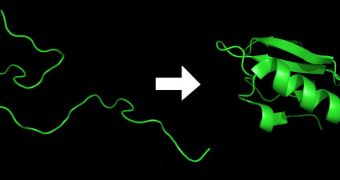One of the most important processes underlying life as we know it is taking place several times per second in each living cell, where proteins undergo a change called folding. This allows them to become specialized in various roles inside other fundamental processes, experts say.
The very function of a protein is dictated by the way it folds, investigators say, considering that one type of fold may expose a certain area for reactions with other molecules, whereas another fold may exposed a similar region, but with a small variations.
Even the slightest changes can cause the function of the molecule to change significantly. Thus far, experts have not been able to make much sense of how a protein takes on its function primarily because there were no methods to watch the molecules folding.
This inconvenience was recently addressed by investigators at the Washington University in St. Louis (WUSL), who were led by Department of Arts & Sciences professor of chemistry Michael L. Gross, PhD.
The expert also holds an appointment as a professor of medicine and immunology in the WUSL School of Medicine (WUSM). He and his team published details of their new investigation in the ltest online issue of the esteemed scientific Journal of the American Chemical Society.
According to the group, the recently-developed technique is a proof-of-principle, that was tested during experiments in which scientists watched the folding of a small protein called barstar. The process takes only microseconds to complete.
“Think of a protein as thousands of atoms connected together by springs,” explains Gross. He is the director of the National Institutes of Health's (NIH) National Center for Research Resources (NCRR) Mass Spectrometry Resource as well.
“If you were to suspend this object with a string from the ceiling and let it flop around, imagine how many shapes it could take. An enormous number, because it is free to move in so many different ways,” he goes on to say.
The 20,000 to 30,000 genes that each individual genome has are responsible for producing up to 2 million different proteins, which should give you an idea of the complexity these essential life molecules have.
“But, at some point any method for predicting protein structure has to be checked against experimental evidence that shows how proteins actually do fold,” Gross concludes.

 14 DAY TRIAL //
14 DAY TRIAL //